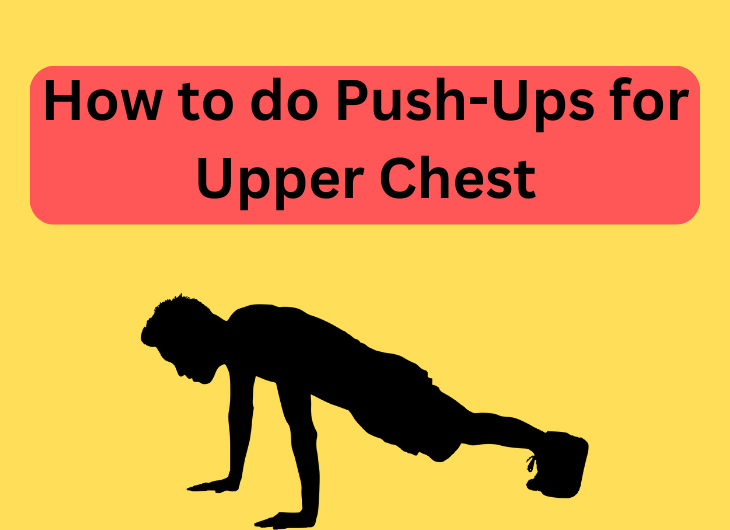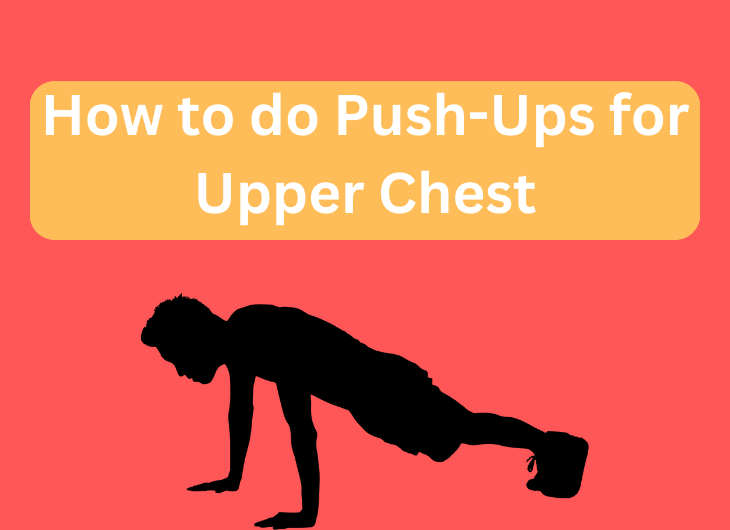How to do Push-Ups for Upper Chest: Mastering the Push-Up
Push-ups are a fundamental and highly effective bodyweight exercise that engages various muscle groups, including the chest, shoulders, triceps, and core. When performed correctly, push-ups can be a powerful tool for developing upper chest muscles and enhancing overall upper body strength. In this comprehensive guide, we will delve into the techniques, variations, and tips to maximize the benefits of push-ups specifically for targeting the upper chest.
Understanding the Upper Chest
Before we delve into the specifics of performing push-ups for the upper chest, it’s crucial to understand the anatomy of the chest muscles. The chest, or pectoral region, is composed of two primary muscle groups: the pectoralis major and the pectoralis minor. The pectoralis major is the larger muscle that comprises the majority of the chest, and it has an upper, middle, and lower portion. The upper chest, in particular, is often a challenging area to target due to its tendency to be less responsive compared to the other areas.
The pectoralis major is a fan-shaped muscle that covers much of the upper front chest. It consists of clavicular and sternal portions. The clavicular part, also known as the upper chest, originates from the clavicle and extends down to the sternum. When performing push-ups to target the upper chest, the goal is to emphasize the activation and growth of this specific part of the pectoralis major.
Proper Push-Up Form
Executing push-ups with the correct form is fundamental to engaging the upper chest muscles effectively. Here’s a step-by-step guide to achieving proper push-up form:
1. Starting Position:
- Begin in a prone position with your hands slightly wider than shoulder-width apart, fingers pointing forward, and arms fully extended.
- Keep your body straight and rigid from head to heels, engaging your core muscles throughout.
2. Descent:
- Lower your body by bending your elbows until your chest is above the floor or at a comfortable depth.
- Ensure your elbows are at a 45-degree angle from your body to effectively target the upper chest.
3. Ascent:
- Push through your hands, extending your elbows and returning to the starting position.
4. Breathing:
- Inhale as you lower your body.
- Exhale as you push back up to the starting position.
Variations to Target the Upper Chest
While the traditional push-up effectively engages the entire chest, incorporating variations can shift the emphasis to the upper chest. Here are several variations that specifically target the upper chest:
1. Incline Push-Ups:
- Perform push-ups with your hands elevated on a stable surface such as a bench, box, or step.
- The elevated position increases the angle of your body and places more emphasis on the upper chest muscles.
2. Decline Push-Ups:
- Place your feet on an elevated surface while keeping your hands on the floor in a standard push-up position.
- The decline angle shifts the focus to the upper chest, engaging the pectoralis major’s upper fibers.
3. Wide-Grip Push-Ups:
- Position your hands wider than shoulder-width apart, ensuring a wider grip.
- The wider grip activates the upper chest muscles more than a standard push-up grip.
4. Diamond Push-Ups:
- Form a diamond shape with your hands by placing your thumbs and index fingers together on the floor.
- Lower your body, keeping your elbows close to your sides, to effectively target the upper chest and triceps.
Tips for Optimizing Upper Chest Engagement
Achieving an effective upper chest workout requires not only proper form and variations but also a holistic approach. Here are some tips to optimize upper chest engagement during push-ups:
1. Mind-Muscle Connection:
- Focus on the muscle you intend to target, in this case, the upper chest. Concentrate on feeling the contraction and stretch in this area during each rep.
2. Squeeze at the Top:
- At the top of each push-up, consciously contract your chest muscles and hold for a moment to maximize the engagement of the upper chest.
3. Controlled Movement:
- Maintain a slow and controlled pace during both the descent and ascent of each push-up to ensure constant tension on the upper chest muscles.
4. Progressive Overload:
- Gradually increase the difficulty of your push-ups by adding more reps, adjusting the incline or decline angle, or incorporating additional weight to challenge your upper chest further.
5. Proper Nutrition and Recovery:
- Ensure a well-balanced diet that supports muscle growth and recovery. Adequate rest and recovery between workouts are equally essential to allow your muscles to repair and grow.
Crafting an Upper Chest-focused Workout Routine
Incorporating an upper chest-focused workout routine into your overall fitness regimen can help you achieve optimal results. Here’s a sample workout routine:
Warm-up:
- Perform dynamic stretches, arm circles, and shoulder rolls to prepare the chest muscles for the upcoming workout.
Exercise Set: Incline Push-Ups
- Perform 3 sets of 10-12 reps with a 45-degree incline, focusing on engaging the upper chest muscles.
Exercise Set: Decline Push-Ups
- Perform 3 sets of 10-12 reps with a 45-degree decline, targeting the upper chest and emphasizing controlled movements.
Exercise Set: Wide-Grip Push-Ups
- Perform 3 sets of 12-15 reps with wider hand placement, maximizing upper chest engagement.
Exercise Set: Diamond Push-Ups
- Perform 3 sets of 10-12 reps, focusing on forming a diamond shape with your hands and targeting the upper chest and triceps.
Cool Down:
- Perform static stretches for the chest, shoulders, and arms to improve flexibility and aid in muscle recovery.
Frequently Asked Questions: How to do Push-Ups for Upper Chest
In this section, we’ll address common questions related to mastering push-ups for targeting the upper chest and achieving optimal results.
1. Q: Can push-ups alone effectively target the upper chest?
A: Yes, push-ups can effectively target the upper chest when performed with the correct form and variations that emphasize the upper chest muscles, such as incline and wide-grip push-ups.
2. Q: How can I ensure I’m engaging my upper chest during push-ups?
A: Focus on a wider hand placement, keeping your elbows at a 45-degree angle from your body during the descent and ascent of the push-up. This technique effectively activates the upper chest muscles.
3. Q: How often should I include push-ups in my workout routine to target the upper chest?
A: Aim for at least two to three times a week, integrating variations that emphasize the upper chest, such as incline or wide-grip push-ups, to effectively target and develop the upper chest muscles.
4. Q: Are there any dietary recommendations to support upper chest muscle growth?
A: To support muscle growth, maintain a diet rich in protein, complex carbohydrates, healthy fats, and adequate calories. Protein is particularly essential for muscle repair and growth.
5. Q: Can women benefit from incorporating upper chest-focused push-ups into their workout routines?
A: Absolutely. Women can benefit from targeting the upper chest to enhance overall upper body strength and achieve a more defined and balanced chest.
6. Q: How can I progress in my upper chest push-up routine?
A: Gradually increase the difficulty by adding more reps, adjusting the incline or decline angle, or incorporating additional weight through a weighted vest or backpack to challenge your upper chest further.
7. Q: Are there any alternatives to push-ups that target the upper chest?
A: Yes, exercises like incline dumbbell press, incline bench press, and chest dips can also effectively target the upper chest muscles.
8. Q: Can push-ups be performed by individuals with pre-existing shoulder or chest injuries?
A: It’s essential to consult with a healthcare professional before performing push-ups or any exercises if you have pre-existing injuries. They can guide you on whether push-ups are safe and provide alternative exercises.
9. Q: How long does it typically take to notice results in the upper chest with a consistent push-up routine?
A: Results vary based on factors like frequency of training, nutrition, and individual fitness levels. Generally, noticeable results may appear within a few weeks to a few months with consistent training and a proper diet.
10. Q: Can seniors or individuals with limited mobility perform upper chest-focused push-ups?
A: Yes, modifications like performing push-ups against a wall or using an elevated surface to reduce the intensity can make push-ups accessible for seniors or those with limited mobility while still targeting the upper chest. Always prioritize safety and consult a healthcare professional if needed.
Conclusion: How to do Push-Ups for Upper Chest
Mastering the push-up for upper chest development involves a combination of proper form, targeted variations, and a focused mindset. By understanding the anatomy of the upper chest and implementing specific techniques, you can effectively engage and strengthen this area, leading to a well-defined and balanced chest.
Consistency, progressive overload, and paying attention to your body’s cues are key to achieving your desired upper chest results. Remember to maintain a healthy lifestyle, including a balanced diet and sufficient rest, to complement your workout routine and support muscle growth effectively. With dedication and persistence, you’ll witness the growth and strength of your upper chest as you integrate these techniques into your fitness journey. So, gear up and start mastering the push-up for a stronger, more sculpted upper chest!





